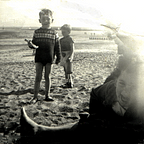Fly Me to the Moon
The story of the song (in other words)
The song just fell out of me. One publisher wanted me to change the lyric to ‘take me to the moon. Had I done that …
Bart Howard only wrote one standard but it was enough to take him into lunar orbit. Fly Me to the Moon would fly high on a cassette carried by astronaut Gene Cernan on Apollo 10 in 1969. A Sony TC-50 portable cassette player was specially adapted to play ‘among the stars’ at low gravity. Of course even the boffins at NASA couldn’t confirm what spring is like on Jupiter and Mars — they’re still working on that one.
That journey to the stars was very much by the scenic route, taking fifteen years. It involved multiple versions by different artists, and endless tweaks and variations. The time signature, musical style and even the initial title: would all end up different places.
What was then called In Other Words was first performed at a cabaret club called The Blue Angel, a name that evoked the glamour of Marlene Dietrich. The address was toney, too: 152 East 55th Street between Lexington and Park Avenues — though punters had to trudge up four floors to enter.
The pianist and musical master of ceremonies was Bart Howard, a former GI from Burlington, Iowa. Howard, whose homosexuality was an open secret, idolised Cole Porter, and so the vibe at the Blue Angel was more High Society than Cabaret. In his public persona the young Iowan was:
the epitome of a certain kind of New York elegance that people that came to New York aspired to. Jim Gavin Intimate Nights: Golden Age Of New York Cabaret
Unlike Porter, Howard did not come from a wealthy background. He had done the hard yards, playing piano for drag acts in smoky rooms out of economic necessity. This also drove his songwriting — which hadn’t yet produced a hit but did fill the set-lists of the club’s singers like Eartha Kitt, Johnny Mathis and Kaye Ballard.
Comedienne Felicia Sanders gave the first performance at The Blue Angel, while Ms Ballard made the first recording. Both versions had Howard’s 3/4 arrangement and were much slower than later interpretations.
Johnnie Mathis, Sylvia Syms and Edy Gorme all released versions in the same mode in the late 50s: lush, orchestral, slightly plodding. Then Peggy Lee took things up a notch with a fine, spare, Billy May arrangement. Her performance on the Ed Sullivan Show in 1960 —mysteriously wandering down a beach — introduced the song to a much wider audience, just as the ‘Space Race’ was entering the national consciousness.
La Lee, no mean songwriter herself, gave Howard some sage advice: “Change the title — no one can remember it — go with the opening phrase”. She also opened the door to a more radical reinvention.
Word went out that Frank wanted the tune for Vegas — but the desert high rollers wouldn’t tolerate their rubber chicken going cold for a super-slow waltz. So in came Quincy Jones, Count Basie and 4/4 at that finger snapping tempo:
Was Bart cross with Frank’s departure from the original score? Not when he saw his next royalty statement. By this point, there were already a hundred versions on the board but as Will Friedwald puts it
The Basie/Jones combination recharged it into a straight swinger… [which]…all but explodes with energy
The Chairman put his foot on accelerator, knocking a full thirty seconds off the duration. He also (as per) messed with the words (‘Oh baby!). But the song was on its way to the Hall of Fame via Huston.
As was Buzz Aldrin, still a bit raw about that silver Moon medal. Buzz loved the tune but not that it accompanied his every public appearance. “Write a follow up,” Aldrin advised Howard. “Call it Get Your Ass to Mars.”
